| |
Updated HHS ART Guidelines/Oct 25 2018
|
| |
| |
Guidelines for the Use of Antiretroviral Agents in Adults and Adolescents Living with HIV
rom Jules: I highlighted & excerpted several key new updated information I believe to be important, including some discussion on comorbidities and ART adverse effects. The entire document is linked to just below....
https://aidsinfo.nih.gov/guidelines/html/1/adult-and-adolescent-arv/37/whats-new-in-the-guidelines-
What's New in the Guidelines?
Last Updated: October 25, 2018; Last Reviewed: October 25, 2018
Ibalizumab (IBA), a CD4 post-attachment inhibitor, was recently approved for use in persons with multidrug-resistant HIV. A review of the results of a clinical trial on IBA use in this setting has been added to the section.
.......Patients with ongoing detectable viremia who lack sufficient treatment options to construct a fully suppressive regimen may be candidates for the recently approved CD4 post-attachment inhibitor ibalizumab (IBA).61 A single-arm, multicenter clinical trial enrolled 40 heavily ART-experienced participants who had multidrug-resistant HIV and who were experiencing virologic failure on an ARV regimen. Subjects received intravenous infusions of IBA every 2 weeks in addition to an optimized background regimen that included at least one additional agent to which the subject's virus was susceptible. At week 24, 43% of participants achieved HIV RNA <50 copies/mL, and 50% of participants achieved HIV RNA <200 copies/mL.62 Of the 27 participants who continued on to the 48-week follow-up study, 59% and 63% had HIV RNA <50 copies/mL and <200 copies/mL, respectively. All 15 patients who had HIV RNA <50 copies/mL at week 24 maintained viral suppression up to week 48.63
Last Updated: October 25, 2018; Last Reviewed: October 25, 2018
Resistance Testing
New information has been added regarding the use of HIV-1 proviral DNA genotypic resistance tests to identify drug resistance mutations, especially in the setting of low-level viremia or when plasma HIV RNA is below the limit of detection. The section now includes a discussion on the benefits and limitations of these tests.
Co-Receptor Tropism Testing
For patients who have undetectable HIV RNA, the Panel now recommends using a proviral DNA tropism assay to assess co-receptor usage before maraviroc is initiated as part of a new regimen.
Dolutegravir and Association with Neural Tube Defects
Preliminary data from Botswana suggest that there is an increased risk of neural tube defects in infants born to women who were receiving dolutegravir (DTG) at the time of conception. In response to these preliminary data, several sections in the Adult and Adolescent Guidelines have been updated to provide guidance for clinicians who are considering the use of DTG or other integrase strand transfer inhibitors (INSTIs) in individuals who are pregnant, or in those of childbearing potential who plan to get pregnant or who are sexually active and not using effective contraception. The sections that have been updated with this new information include:
• What to Start
• Virologic Failure
• Optimizing Antiretroviral Therapy in the Setting of Viral Suppression (formerly Regimen Switching in the Setting of Virologic Suppression)
• Acute and Recent (Early) HIV-1 Infection
• Adolescents and Young Adults with HIV
• Women with HIV
Virologic Failure
• This section was updated to include newly reported data and new language on recently published clinical trial data for first-line ARV treatment failure.
• The Panel notes that, in some persons with multidrug-resistant HIV, DTG may be the only treatment option, or one of few treatment options. Accordingly, the language on the use of DTG in those of childbearing potential has been updated. The section now emphasizes that clinicians and patients should discuss the risk of neural tube defects if pregnancy occurs while the patient is taking DTG, as well as the risk of persistent viremia in the patient and the risk of HIV transmission to the fetus if pregnancy occurs while the patient is not on effective ARV therapy. The decision of whether to initiate or continue DTG should be made after carefully considering these risks.
• Ibalizumab (IBA), a CD4 post-attachment inhibitor, was recently approved for use in persons with multidrug-resistant HIV. A review of the results of a clinical trial on IBA use in this setting has been added to the section.
What to Start
The following changes have been made to the recommendations for initial antiretroviral (ARV) regimens:
• Bictegravir/Tenofovir Alafenamide/Emtricitabine (BIC/TAF/FTC):BIC is a new INSTI that is approved by the Food and Drug Administration (FDA) as part of a single-tablet regimen (STR) that also includes TAF and FTC. This regimen is now classified as a Recommended Initial Regimen for Most People with HIV.
• Elvitegravir/Cobicistat/Emtricitabine with Tenofovir Alafenamide or Tenofovir Disoproxil Fumarate (EVG/c/FTC/TAF or EVG/c/FTC/TDF): These regimens have been moved to the category of Recommended Initial Regimens in Certain Clinical Situations. This change was made because these combinations include cobicistat, a pharmaco-enhancer that inhibits cytochrome P450 3A4 and increases the likelihood of drug-drug interactions. EVG also has a lower barrier to resistance than DTG and BIC.
• Doravirine (DOR): DOR, a new non-nucleoside reverse transcriptase inhibitor, was recently approved by the FDA and is available as a single-drug tablet and as part of an STR that also includes TDF and lamivudine (3TC). DOR/TDF/3TC and DOR plus TAF/FTC have been added to the category of Recommended Initial Regimens in Certain Clinical Situations.
• Dolutegravir plus Lamivudine (DTG plus 3TC): This two-drug regimen is now one of the regimens to consider when abacavir, TAF, or TDF cannot be used or are not optimal.
• A new table, Table 6b, has been added to provide guidance to clinicians who are considering the use of DTG or other INSTIs in those who are pregnant and in those of childbearing potential.
• Several new tables (Tables 8a-8d) have been added to the sections for the individual drug classes. These tables compare the characteristics of the different drugs within the classes.
• Updates have been made throughout the section with new safety and clinical trial data.
Boosted atazanavir has relatively few metabolic adverse effects in comparison to other boosted-PI regimens; however, in a randomized clinical trial, ATV/r had a higher rate of adverse effect-associated drug discontinuation than DRV/r or RAL.11 In a substudy of this trial, and in a separate cohort study, ATV/r use was associated with slower progression of atherosclerosis, as measured by carotid artery intima medial thickness.16,17
Most EFV-based regimens have excellent virologic efficacy, including in patients with high HIV RNA (except when EFV is used with ABC/3TC); however, the relatively high rate of central nervous system (CNS)-related side effects reduces the tolerability of EFV-based regimens.
DOR has CNS tolerability advantages over EFV and favorable lipid effects when compared with both DRV/r and EFV. It also has fewer potential drug interactions than EFV or RPV, and, unlike RPV, virologic effects are not compromised in those with high HIV RNA levels and low CD4 cell counts.
In those patients who cannot safely be prescribed a combination regimen that contains two NRTIs, there are now several two-drug treatment options. DTG plus 3TC is an option when ABC, TAF, and TDF cannot be used or are not optimal. Two randomized trials that collectively enrolled >1,400 participants with baseline HIV RNA levels <500,000 copies/mL compared DTG plus 3TC to a three-drug regimen of DTG plus TDF/FTC. At week 48, DTG plus 3TC was noninferior to DTG plus TDF/FTC in terms of virologic efficacy. No treatment-emergent resistance was seen in either group.12 Another option that can be considered is the combination of DRV/r (once daily) plus RAL (twice daily), but this combination can only be used in those with baseline CD4 cell counts >200 cells/mm3 and HIV RNA levels <100,000 copies/mL.24 A small, randomized trial indicated that once-daily DRV/r plus 3TC had similar efficacy to DRV/r plus TDF/3TC, although this study has yet to be published.25
Factors to Consider When Selecting an Initial Regimen
Specific Comorbidities or Other Conditions:
• Cardiovascular disease, hyperlipidemia, renal disease, liver disease, osteopenia/osteoporosis or conditions associated with bone mineral density (BMD) loss, psychiatric illness, neurologic disease, drug abuse or dependency requiring narcotic replacement therapy
• Pregnancy or those with the potential to become pregnant. Clinicians should refer to Table 6b and the latest Perinatal Guidelines for more detailed recommendations on the safety and effectiveness of ARV drugs during conception and throughout pregnancy.
• Coinfections: hepatitis B virus (HBV), hepatitis C virus (HCV), TB
Patient/Adherence-Related Factors (see
Adherence to the Continuum of Care)
• Comorbidities that may affect adherence (e.g., active substance abuse,
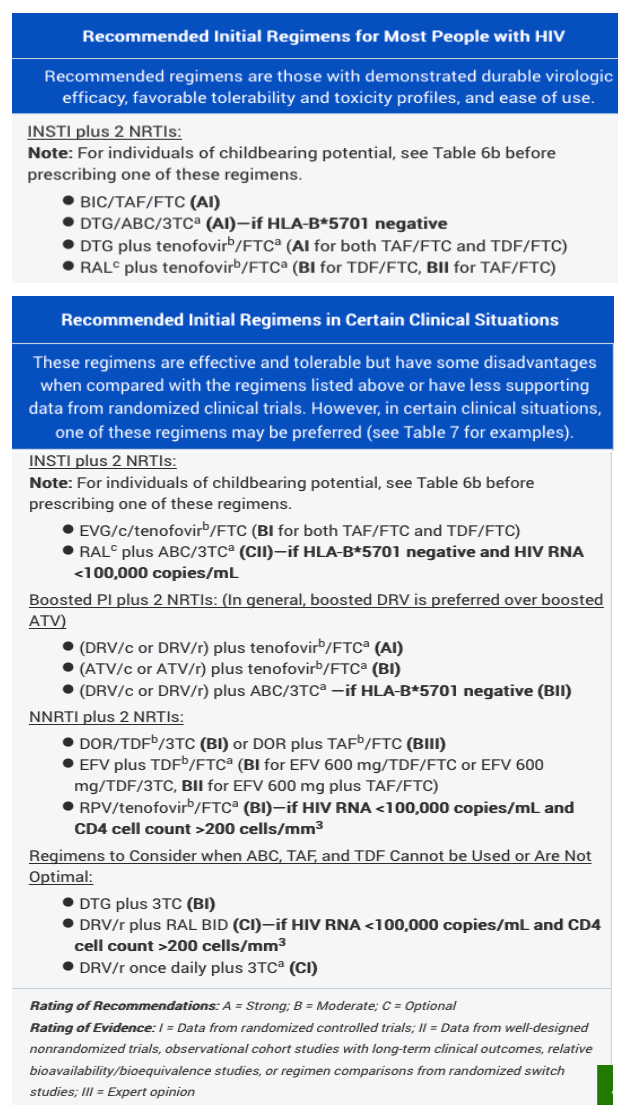
Limitations to Treatment Safety and Efficacy
Adverse Effects of Antiretroviral Agents
Last Updated: October 25, 2018; Last Reviewed: October 25, 2018
Adverse effects have been reported with all ARV drugs and, in the earlier era of combination ART, adverse effects were among the most common reasons for switching or discontinuing therapy and for medication nonadherence.1 Fortunately, newer ARV regimens are associated with fewer serious and intolerable adverse effects than regimens used in the past. Generally, less than 10% of ART-naive patients enrolled in randomized trials experience treatment-limiting adverse events. However, the long-term complications of ART can be underestimated, because most clinical trials use highly specific inclusion criteria when enrolling participants and the duration of participant follow-up is relatively short. As ART is now recommended for all patients regardless of CD4 cell count, and because therapy must be continued indefinitely, the focus of patient management has evolved from identifying and managing early ARV-related toxicities to individualizing therapy to avoid long-term adverse effects, including diabetes, accelerated vascular disease, kidney dysfunction, and bone loss. To achieve sustained viral suppression over a lifetime, both long-term and short-term ART toxicities must be anticipated and overcome. The clinician must consider potential adverse effects when selecting an ARV regimen, as well as the individual patient's comorbidities, concomitant medications, and prior history of drug intolerances.
Several factors may predispose individuals to adverse effects of ARV medications, such as:
• Concomitant use of medications with overlapping and additive toxicities.
• Comorbid conditions that increase the risk of or exacerbate adverse effects. For example, underlying liver disease from alcohol use, co-infection with viral hepatitis, and/or liver steatosis2,3 may increase the risk of hepatotoxicity when drugs such as efavirenz (EFV) or protease inhibitors are used; psychiatric disorders may be exacerbated by EFV, rilpivirine, and, infrequently, by integrase strand transfer inhibitors;4,5 and borderline or mild renal dysfunction increases the risk of nephrotoxicity from tenofovir disoproxil fumarate (TDF).
• Drug-drug interactions that may increase toxicities of ARV drugs or concomitant medications.
• Genetic factors that predispose patients to abacavir (ABC) hypersensitivity reaction,6,7 EFV neuropsychiatric toxicity and QTc prolongation,8,9 and atazanavir (ATV)-associated hyperbilirubinemia.10
Information on the adverse effects of ARVs is outlined in several tables in the guidelines. Table 15 provides clinicians with a list of the most common and/or severe ARV-associated adverse events for each drug class. The most common adverse effects of individual ARV agents are summarized in Appendix B, Tables 1-6.
table - https://aidsinfo.nih.gov/guidelines/htmltables/1/6403
Switching Antiretroviral Drugs Due to Adverse Effects
Some patients experience treatment-limiting toxicities associated with ART. In these cases, ART must be modified. ART-associated adverse events can range from acute and potentially life-threatening to chronic and insidious. Serious life-threatening events (e.g., hypersensitivity reaction due to ABC, symptomatic hepatotoxicity, or severe cutaneous reactions) require the immediate discontinuation of all ARV drugs and re-initiation of an alternative regimen without overlapping toxicity. Toxicities that are not life-threatening (e.g., urolithiasis with ATV or renal tubulopathy with TDF) can usually be managed by substituting another ARV agent for the presumed causative agent without interrupting ART. Other chronic, non-life-threatening adverse events (e.g., dyslipidemia) can be addressed either by switching the potentially causative agent for another agent or by managing the adverse event with additional pharmacological or nonpharmacological interventions. Management strategies must be individualized for each patient.
Switching from an effective ARV regimen (or agent) to a new regimen (or agent) must be done carefully and only when the potential benefits of the change outweigh the potential complications of altering treatment. The fundamental principle of regimen switching is to maintain viral suppression. When selecting a new agent or regimen, providers should be aware that resistance mutations are archived in HIV reservoirs, regardless of when the mutations were identified by genotypic resistance testing. Even if resistance mutations are absent from subsequent resistance test results, they may reappear under selective drug pressure. It is critical that providers review the following information before implementing any treatment switch:
• The patient's medical and complete ARV history, including prior virologic responses to ART;
• All previous resistance test results;
• Viral tropism (if MVC is being considered);
• HLA-B*5701 status (if ABC is being considered);
• Comorbidities;
• The patient's pregnancy status, ability to use effective contraceptives, and desire for pregnancy (if DTG is being considered for patients of child-bearing potential);
• HBV status, since patients with evidence of chronic HBV infection should not discontinue TDF or TAF unless a regimen contains another agent that is active against HBV;
• Adherence history;
• Prior intolerances to any ARVs; and
• Concomitant medications and supplements, taking into consideration any potential drug interactions with ARVs.
A patient's willingness to accept new requirements for food or dosing must also be assessed. In some cases, medication costs may also be a factor to consider before switching treatment. Signs and symptoms of comorbidities, adverse effects of concomitant medications, or HIV itself may mimic adverse effects caused by ART. Therefore, clinicians should investigate all potential causes for an adverse event. In the case of a severe adverse event, it may be necessary to discontinue or switch ARVs pending the outcome of such an investigation. For the first few months after an ART switch, the patient should be closely monitored for any new adverse events. The patient's viral load should also be monitored to assure continued viral suppression.
Table 16 lists several major ART-associated adverse events and the options for appropriate switches between agents in an ARV regimen. The table focuses on the ARVs most commonly used in the United States and lists substitutions that are supported by ARV switch studies, the findings of comparative ARV trials and observational cohort studies, or expert opinion. Switching agents in a successful ARV regimen should be done carefully and only when the potential benefits of the change outweigh the potential complications of altering treatment.
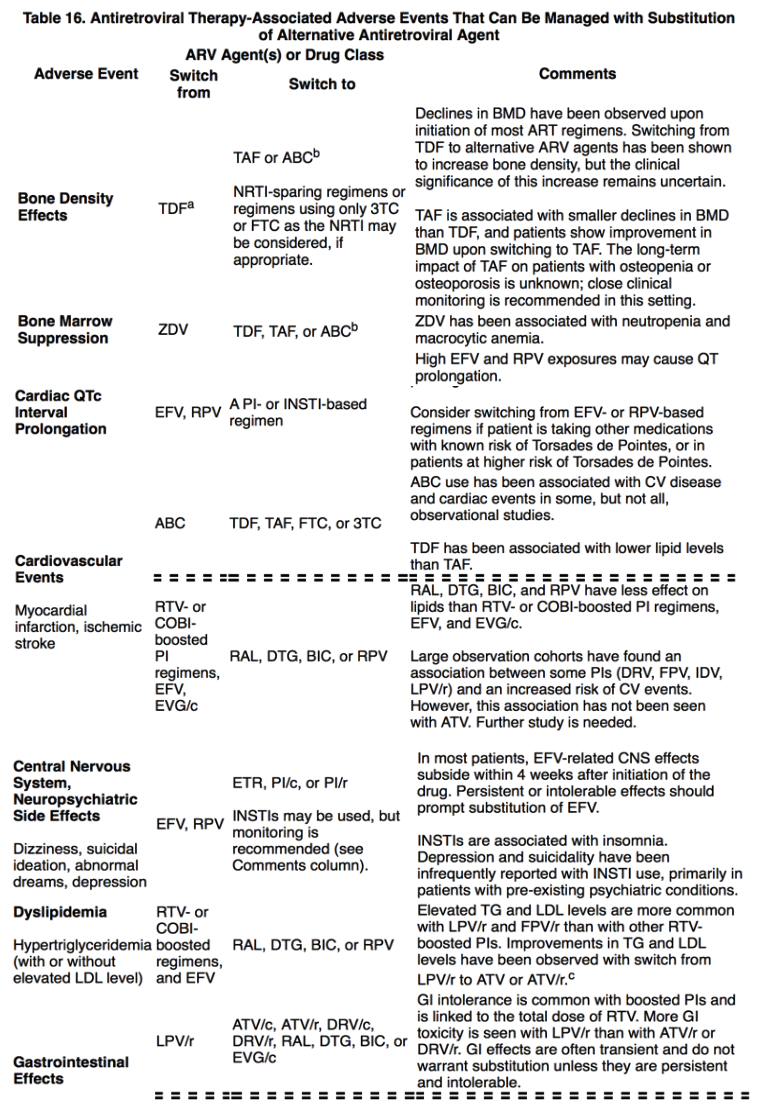
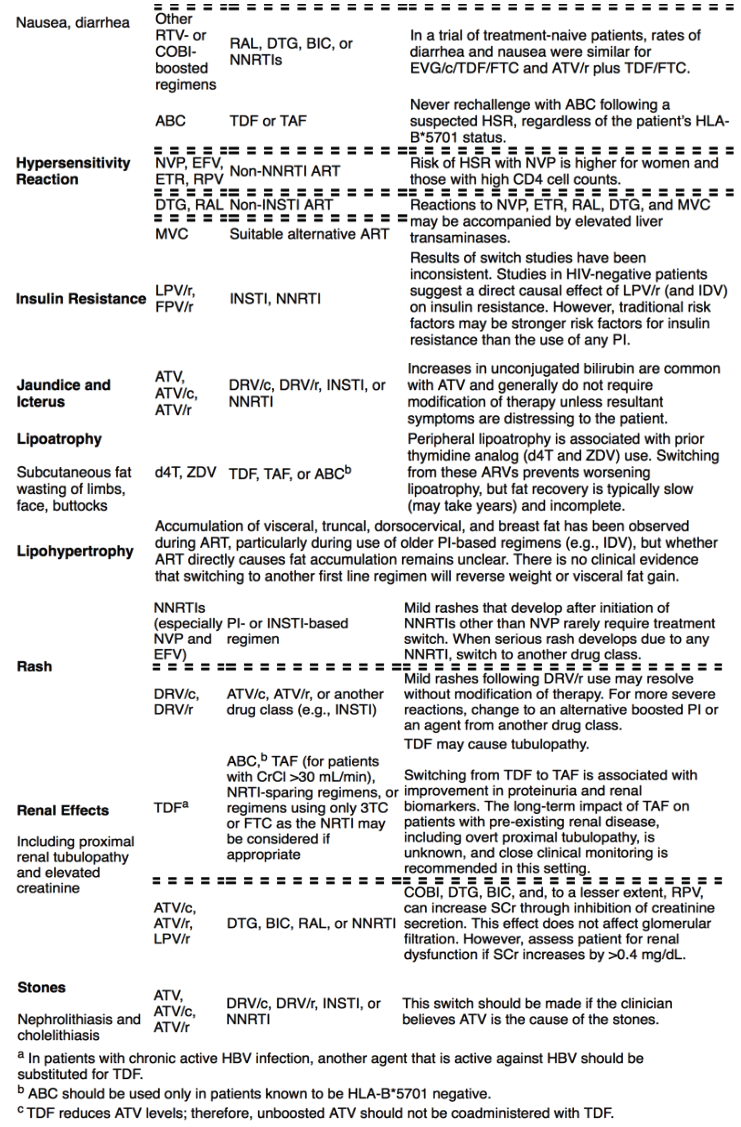
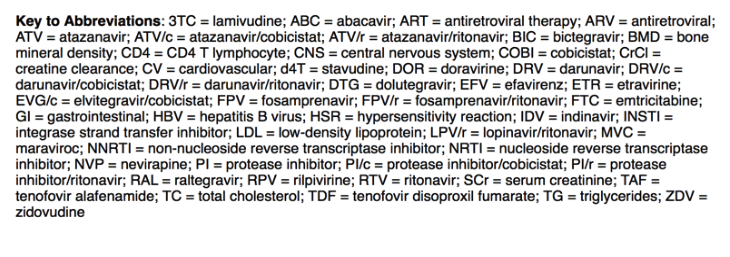
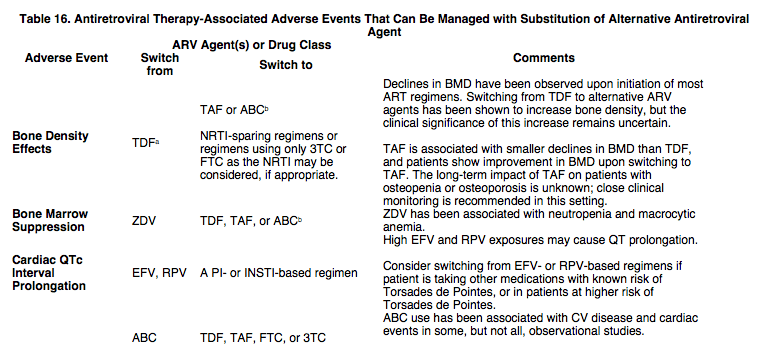
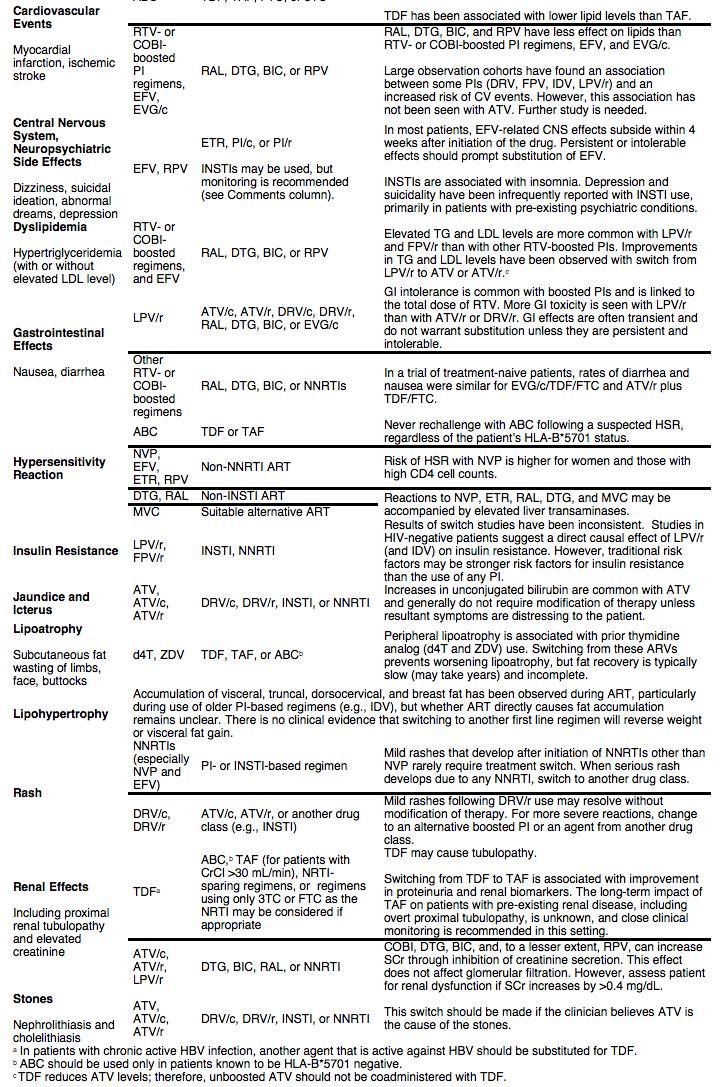

|
|
| |
| |
|
|
|